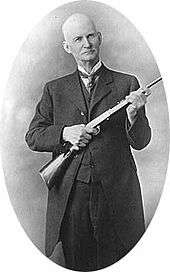Winchester Model 1892
| Winchester Model 1892 | |
|---|---|
| Type | Lever-action centerfire rifle |
| Place of origin | United States |
| Production history | |
| Designer | John Browning |
| Manufacturer | Winchester Repeating Arms Company |
| Produced | 1892–1945 |
| No. built | 1,007,608 |
| Specifications | |
| Caliber |
|
| Action | Lever action |
| Feed system | 15-round tube magazine |
The Winchester Model 1892 was a lever-action repeating rifle designed by John Browning as a smaller, lighter version of his large-frame Model 1886, and which replaced the Model 1873 as the company's lever-action for pistol-caliber rounds such as the .44-40.[1]
History
When asked by Winchester to design an improved lever action to compete with a recent Marlin offering, John Browning said he would have the prototype completed in under a month or it would be free. Within 2 weeks, Browning had a functioning prototype of the 92.[2] Calibers for the rifle vary and some are custom-chambered. The original rounds were the .32-20, .38-40, and .44-40 Winchester centerfire rounds, followed in 1895 by the new .25-20.[3] A few Model 92s chambered for .218 Bee were produced in 1936-38.[3] Rifles in .44-40 proved to be most popular, far outstripping sales of the other chamberings.
The Winchester Models 53 (1924) and 65 (1933) were relabeled Model 1892s. Admiral Robert E. Peary carried an 1892 on his trips to the North Pole.,[3] and Secretary of War Patrick Hurley was presented with the one millionth rifle on December 13, 1932. Famous Amazon explorer Percy Fawcett carried a Winchester 92 on his expeditions and the famous jaguar hunter Sasha Siemel also used a short barreled Winchester 92 carbine (with a bayonet attached). The Royal Navy used 21,000 examples during World War One.[4]
1,007,608 Model 1892 rifles were made by the original Winchester company. The Depression greatly affected sales of the Winchester 92, and at the start of World War Two Winchester dropped production when it retooled for the war effort. Production was not resumed after the war. Model 92 manufacture was resumed in the 1970s by Amadeo Rossi in Brazil; more recently by Chiappa Firearms, an Italian factory; by Browning in Japan; and by Winchester in Japan. In its modern form, using updated materials and production techniques, the Model 1892's action is strong enough to chamber high pressure handgun rounds, such as .357 Magnum, .44 Magnum, and .454 Casull. Despite being designed for smaller cartridges, the 1892s dual forward locking-block action is actually stronger than Browning's rear-locked Model 1894.[5]
Popular culture
.jpg)
Although the Model 1892 made its debut after the closing of the American frontier, and the true "Guns that Won the West" were the earlier Models 1866 and 1873, nonetheless the '92 became an indelible icon of Western mythology through its use in hundreds of motion pictures and television shows, standing in for its older siblings. John Wayne famously carried Model 92s in dozens of films and owned several personally, some with the distinctive oversized "loop" lever. Other notable screen 92s were those of Chuck Connors in The Rifleman and Steve McQueen in Wanted: Dead or Alive.[6] The Winchester Model 1892 is not limited to film in its media appearances; for example, in the video game Half-Life 2, the non-player character Father Grigori carries one.
Hollywood studios purchased the '92 in quantity because it was in regular production (until World War II) but looked sufficiently like Old West Winchesters to substitute for valuable antiques, and because in calibers .44-40 and .38-40 it could fire, together with the Colt Single Action Army "Peacemaker" revolver, the standard Five-in-One blank cartridge. This latter practice mirrored the real cowboys, who found it convenient to carry a rifle and a revolver chambered with the same ammunition.
Modern copies
Garate, Anitua y Cia of Eibar, Spain copied the Model 1892 as Tigre in .44 Largo (.44-40 Win.) with a 22-inch barrel, 12 shot magazine, military sights, and saddle ring. Many were made with sling swivels. Production between 1915-1937 totalled 1,034,687 rifles. From 1923 on they were issued to various Spanish services including the Guardia Civil. Tigre carbines were exported in large numbers to South American countries, and to the U.S. in the 1950s.
Winchester ended production of the Model 1892 in 1941; however, arms manufacturers such as Browning, Chiappa and Rossi have continued to produce copies. Versions of the Model 1892 have continued to be produced almost continuously since Winchester ended its production run. They range in quality and price from midrange firearms to highly decorated presentation pieces.
Winchester produced limited numbers of the Model 1892 in 1997. In November, 2006, Winchester announced the Model 1892 John Wayne 100th Anniversary Rifle, chambered in Win 44-40. Since then, Winchester has offered several versions of the Model 1892. In early 2012, Winchester produced a limited number of Large Loop Carbines in 4 calibers; .44 Magnum, .357 Magnum, .44-40 (44 WCF) and .45 Colt.
See also
References
- ↑ "Winchester Model 1892 Deluxe Takedown Edition". American Rifleman. 2009.
- ↑ http://www.gunsandammo.com/content/brownings-other-rifles?page=3
- 1 2 3 Henshaw, Thomas (1993). The History of Winchester Firearms 1866-1992. New York: Winchester Press. pp. 35–37. ISBN 978-0-8329-0503-2.
- ↑ Elks, Ken, ed. (2016). British Secondary Small Arms 1914-1919 – Vol. 1: Rifles and Carbine. Canterbury, Kent: Solo Publications. ISBN 9780-956852908.
- ↑ http://www.leverguns.com/articles/paco/45coltlevergun.htm
- ↑ Mueller, Jim (2001). "Blasters From The Past". American Cowboy. Active Interest Media, Inc. 7 (6): 59–62. ISSN 1079-3690.
6. The modified rifle used by Lucas McCain (played by Chuck Connors) in the TV show the Rifleman, although it took place in the 1880s, years before the rifle's creation.

